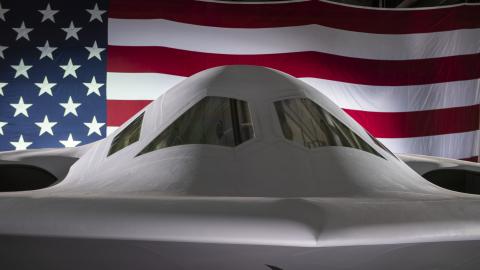The B-21 Raider’s first flight last month was a noteworthy milestone for U.S. airpower and a signal of the Pentagon’s commitment to conventional and nuclear deterrence. But warfare changed during the past 20 years as the B-21 moved from idea to reality. Uncrewed systems, electromagnetic warfare, artificial intelligence, and commercial satellite capabilities have altered the battlefield. To remain relevant into the 2030s and beyond, the B-21 will need a capable team around it.
Stealth bombers are intended to deliver what the Air Force calls “affordable mass,” or the ability to use smaller, less-expensive weapons because the airplane delivering them can get close to the target. As the war in Ukraine suggests, sneaking up on a target is getting harder as air defense radars improve and are augmented by space-based sensors like those being fielded by a host of commercial companies and a few governments.
The B-21 is built to hide from enemy radars, infrared detectors, or video cameras. The challenge will be doing so from every direction, and over the next several decades as more satellites and drones become part of enemy air defense networks. If B-21s have to launch from farther away, they will have to carry larger, more expensive, missiles that may need updated targeting data because they could be in flight for an hour or longer.
Helping the Bomber Get Through
During the 20th century, airpower experts argued that bombers almost always would be able to reach their targets. Air defenses were not that accurate and could not reach high altitudes. That changed with modern systems like those that today make the skies above Ukraine too dangerous for most aircraft.
A bomber like the B-21 will use its low profile, radar-absorbing coatings and unique exhaust ducting to avoid detection, but still might be picked up if viewed from the right angle in the right conditions. To make it harder to classify and target, the Air Force could deploy uncrewed aircraft with the B-21 to jam radars, act as electronic or infrared decoys, or attack air defenses before they can engage the bomber.
But these collaborative combat aircraft, as the Air Force calls them, probably should not accompany bombers for their whole journey from Missouri or Hawaii to the South China Sea. If they did, the drones would need to have the same range, speed, and stealth as the bomber to avoid drawing attention to the team before reaching the target. The resulting cost may make uncrewed teammates impractical to buy at scale.
Instead, the Air Force should plan to assemble the B-21’s supporting cast in the field. Crewed or uncrewed ships, aircraft, or troops on the ground could launch smaller, less-stealthy, and less-expensive jamming, decoy, or anti-radiation drones that would join B-21s on their way to the target area. And while driving a destroyer or C-17 transport into the South China Sea may be too risky for wartime drone delivery, uncrewed surface vessels like the Navy’s Sea Hunter, uncrewed undersea vehicles such as the Orca, or uncrewed aircraft like the MQ-9B may be perfect for the job.
Making Every Shot Count
Perhaps the biggest challenge to affordable mass will be making sure each missile a B-21 launches actually reaches its target. Targets worth using a B-21 to strike will be defended; even if the B-21 gets through, its weapons may not. And a savvy adversary like China will put its own mass to work, especially in a fight close to home such as around Taiwan. Chinese forces are likely to use commercial vessels, fake missile launchers, and older ships and aircraft to soak up U.S. attacks and protect their amphibious transports or high-end bombers.
Smaller uncrewed systems also can help the B-21 sort through a chaotic battlefield at sea or ashore and tie up enemy air defenses so U.S. missiles can reach their intended targets. Drone teammates like those protecting the B-21 could help identify high-value targets and jam or attack air defenses as part of U.S. missile salvos. And on the water, small uncrewed surface drones like those threatening Russia’s Black Sea Fleet could create multi-axis attacks against enemy ships that make them more susceptible to air attack.
Assembling a team to make affordable mass a reality shifts much of the Pentagon’s technology challenge going forward from developing exquisite new platforms like the B-21 to integrating those that are already available. The Raider’s potential teammates are already in use or in the field in some form. But the communication networks, mission planning and control software, and data fabrics they will use are not yet in place.
The Pentagon is taking steps to make teams like that needed by the B-21 not only feasible but commonplace. However, that effort requires moving money into new investments — which requires Congress to pass a defense budget — and the sustained attention of leaders who often are focused on new ships, aircraft, or systems. The time and money that went into impressive platforms like the B-21 will be for naught unless the Defense Department and its supporters in Congress put as much money and effort into integration as they do into hardware.


















